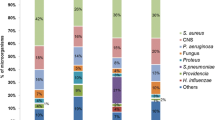Abstract
Bacteria are an important cause of acute otitis media and successful treatment depends on achieving inhibitory or bacteriacidal antimicrobial drug concentrations in the middle ear. To evaluate further otitis media treatment success and failure, we developed a chinchilla model to study antimicrobial drug penetration through the middle ear mucosa. Using quantitative histomorphometry, we measured the middle ear space in 10 chinchillas and found a mean ±SD volume of 2.09 ± 0.08 ml and a mean SD surface area of 14.41 ± 1.48 cm2. To measure the apparent rate constant (K e) of antibiotic elimination from the middle ear, through the middle ear mucosa, an antibiotic solution was inoculated into the middle ear cavity, and samples were aspirated between 1 and 8 hr later. In normal ears, the mean K e ±SD for amoxicillin was 0.118 ± 0.013 hr−1, that for a trimethoprim 0.461 ± 0.090 hr−1, and that for sulfamethoxazole 0.265 ± 0.062 hr−1. In ears inoculated with type 7F Streptococcus pneumoniae to induce acute otitis media, the K e ±SD increased for all three drugs (P < 0.05): amoxicillin to 0.286 ± 0.089 hr−1, trimethoprim to 0.662 ± 0.118 hr−1, and sulfamethoxazole to 0.411 ± 0.056 hr−1. These values demonstrate that amoxicillin had the lowest apparent penetration rate constant of the three antibiotics but the greatest increase from normal to infected mucosa (142%). Trimethoprim had the highest apparent penetration rate constant of the three antibiotics but the smallest increase from normal to infected mucosa (44%), while the sulfamethoxazone apparent penetration rate constant increased from normal to infected mucosa by 55%. The K e for amoxicillin was the same for inoculation volumes of 0.8 and 1.6 ml (P = 0.557) and the same for sampling intervals of 4 and 8 hr (P = 0.054). All three antimicrobial drug concentration–time curves were log-linear, as predicted by Fick's first law of diffusion. In conclusion, this model overcomes the technical limitations of previous models and permits investigation of the many factors that can influence antibiotic penetration into the middle ear and reduce otitis media treatment efficacy.
Similar content being viewed by others
REFERENCES
G. S. Giebink and D. M. Canafax. In Aronoff, Hughes, Kohl, Speck, and Wald (eds.), Advances in Pediatric Infectious Diseases, Year Book Medical, Chicago, 1988.
C. D. Bluestone and J. O. Klein. Otitis Media in Infants and Children, W.B. Saunders, Philadelphia, PA, 1988.
D. W. Teele, J. O. Klein, B. A. Rosner, and the Greater Boston Otitis Media Study Group. Pediatrics 74:282–287. (1984).
D. M. Canafax, N. Nonomura, G. R. Erdmann, C. T. Le, S. K. Juhn, and G. S. Giebink. Pharm. Res. 6:279–285 (1989).
Y. Hanamure and D. J. Lim. Am. J. Otolaryngol. 3:127–143 (1987).
G. S. Giebink, W. L. Meyerhoff, and E. I. Cantekin. In Experimental Models in Antimicrobial Chemotherapy, Vol. 1, Academic Press, London, 1986, pp. 213–236.
G. S. Giebink. Rev. Infect. Dis. 3:342–352 (1981).
G. R. Erdmann, D. M. Canafax, and G. S. Giebink. J. Chromatogr. 433:187–195 (1988).
M. Barza and G. Cuchural. J. Antimicrob. Chemother. 15 (Suppl.):59–75 (1985).
K. K. H. Chan and K. Wnuck. Comp. Programs Biomed. 16:27–34 (1983).
L. L. Van Etta, L. P. Peterson, C. E. Fasching, and D. N. Gerding. J. Infect. Dis. 146:423–428 (1982).
T. Bergan. Rev. Infect. Dis. 3:45–64 (1981).
C. Hansch and A. J. Leo. Substituent Constants for Correlation Analysis in Chemistry and Biology, John Wiley, Chichester, 1979.
Author information
Authors and Affiliations
Rights and permissions
About this article
Cite this article
Jossart, G.H., Erdmann, G.R., Levitt, D.G. et al. An Experimental Model for Measuring Middle Ear Antimicrobial Drug Penetration in Otitis Media. Pharm Res 7, 1242–1247 (1990). https://doi.org/10.1023/A:1015977603224
Issue Date:
DOI: https://doi.org/10.1023/A:1015977603224




